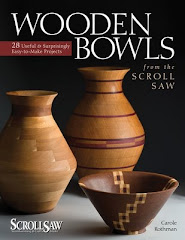Most scroll saws have tilting tables, but some have a stationary table and tilting arm. Having used both designs, and having just ruined a project because the blade was cutting at the wrong angle, I decided to try to prevent someone else from repeating my mistake.
My problem arose because the blade was not perpendicular to the table at the zero setting on the saw's angle gauge. If that's off, then the angle gauge will not be accurate.
On the Hegner, with a tilting table and blade clamps that don't use set screws, the blade is always perpendicular to the table at the zero setting. However, because of the possibility of parallax when reading the gauge, I use an engineer's square to check for true vertical. And, when dealing with fractions of angles, I use a Wixey digital angle gauge on the blade and table to double check. It's tricky to hold the Wixey on the little blade, but possible.
On the Jet, the blade may not be perpendicular when the gauge says that it is because the top and bottom set screws of the clamps are positioned to create a slight tilt when the blade is clamped. The usual fix is to move the upper set screws in the cam clamping mechanism in or out until the blade is vertical and to leave the bottom one alone. I made the upper correction, but may have inadvertently changed to a different lower clamp, which resulted in the tilt being off since the lower clamp also uses a set screw. The cut was off by over half a degree, enough to ruin the project.
Most of the time, small deviations don't matter, even with bowls, especially since I always increase the angle slightly to allow for a margin of error. However, for double-bevel inlay or for collapsible baskets, half a degree can make a big difference.
The moral of my story: be sure your blade is perpendicular to the table when the angle gauge reads zero. If you get into the habit of checking this each time you begin your work, you'll save yourself a lot of time, grief, and wood.
Friday, March 24, 2017
Subscribe to:
Post Comments (Atom)





Your contents are too straightforward to browse and easy to understand.
ReplyDeletewww.sawspecialists.com/best-miter-saw-reviews/